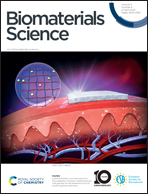Antifungal activity of designed α-helical antimicrobial peptides†
Abstract
Antimicrobial resistance (AMR) has become a major global health concern prompting the quest for new antibiotics with higher efficiency and less proneness to drug resistance. Antimicrobial peptides (AMPs) offer such properties and have therefore gained increasing attention as a new generation of antibiotics to overcome AMR. In an attempt to develop new highly selective and highly efficient antifungal peptides, a sequence (named At1) originating from the natural AMP Ponericin-W1 was used as a lead sequence for rational design of a series of short cationic antifungal peptides named At2–At12. The charge, hydrophobicity, and terminal amino acids of the peptides were modified in a systematic way to investigate the effect of such structural changes on the biological activity of the peptides. Among all the designed peptides, three peptides (coded as At3, At5 and At10) exhibited high antifungal activity without any significant hemolytic activity in human red blood cells. The higher selectivity of these peptides for fungal cells over human cells was further confirmed in cocultures of Candida albicans and human foreskin fibroblasts. These three peptides lacked any hydrophilic residues in their hydrophobic domain, contained lysine residues in their hydrophilic region and had an overall charge of 7+. They also had a higher helical content in microbial membrane mimicking DPPG SUVs than the rest of the peptides. The fungi did not develop any resistance to the designed antifungal peptides even after 25 generations indicating low AMR. At5 was also used in vivo for the treatment of wounds infected with Candida albicans in mice and showed superiority over fluconazole for treating infection and accelerating wound healing. There was an interplay between the hydrophobicity and positive charge density to determine the antifungal activity of the peptides. The results from this study suggest this class of antifungal peptides as promising candidates for antifungal drugs with high efficiency, high biocompatibility and low propensity for drug resistance.



 Please wait while we load your content...
Please wait while we load your content...